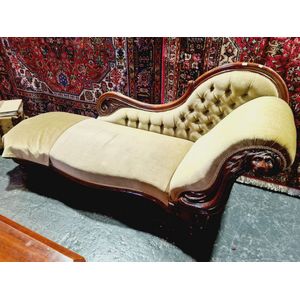Mahogany Lion Chaise Longue with Green Velvet Upholstery
Single ended chaise longue, 19th century. mahogany with green velvet upholstery, deep buttoned back and lion mask decoration
You must be a subscriber, and be logged in to view price and dealer details.
Subscribe Now to view actual auction price for this item
When you subscribe, you have the option of setting the currency in which to display prices to $Au, $US, $NZ or Stg.
This item has been sold, and the description, image and price are for reference purposes only.
- Mahogany - Mahogany is a dense, close grained red-coloured timber from the West Indies and Central America. It was first imported into Europe in the the early 18th century and its use continued through the 19th century. It was popular for furniture making because of its strength, the wide boards available, the distinctive grain on some boards, termed flame mahogany and the rich warm colour of the timber when it was polished.. The "flame" was produced where a limb grew out from the trunk of the tree, and this timber was usually sliced into veneers for feature panels on doors, backs and cornices.
Some terms used to describe mahogany relate to the country from which it originally came, such as "Cuban" mahogany, "Honduras" mahogany etc. However unless the wood has been tested the names assigned are more a selling feature, rather than a true indication of the timber's origin. - Lion Mask - The lion mask has been used for centuries in various forms of art and design, including furniture, silver, and ceramics, and is usually y depicted as a stylized representation of the face of a lion, often with an open mouth and protruding tongue. and is often used as a handle, knob, or other decorative element.
In furniture design, lion masks were popular in the neoclassical and Empire styles of the late 18th and early 19th centuries. They were often used as decorative elements on the legs or arms of chairs, as well as on cabinet and drawer pulls. It was also used as a handle, knob, or other decorative element.
In silverware design, lion masks were often applied to tea and coffee pots, as well as on candlesticks, snuff boxes, and other small silver items. The lion mask was often used in combination with other neoclassical motifs, such as laurel wreaths or acanthus leaves, to create a sense of grandeur and classical elegance.
In ceramics, lion masks were often depicted in relief, and were sometimes used in combination with other decorative elements, such as garlands or swags.
This item has been included into following indexes:
